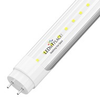Introduction
Floodlights are an essential part of modern outdoor lighting solutions. They provide powerful illumination, improving security and visibility during the night. In this comprehensive guide, we will delve into the various types of floodlights available in the market, helping you choose the right one for your specific needs.
Understanding Floodlights
Before we dive into the different types of floodlights, it's essential to understand what they are and how they work. Floodlights are high-intensity artificial lights designed to cover a wide area. They are commonly used for outdoor lighting, including sports stadiums, parking lots, and building exteriors. Floodlights are an excellent choice for illuminating large spaces efficiently.
Types of Floodlights
Let's explore the different types of floodlights available:
1. Halogen Floodlights
Halogen floodlights are a popular choice due to their affordability and brightness. They produce a warm, white light that closely resembles natural daylight. However, they are not the most energy-efficient option and can generate a significant amount of heat.
2. LED Floodlights
LED floodlights have gained immense popularity in recent years for several reasons. They are highly energy-efficient, lasting longer and consuming less power than traditional options. LEDs also come in various color temperatures, allowing you to choose the ambiance you desire for your outdoor space.
3. Solar-Powered Floodlights
Solar-powered floodlights are an eco-friendly option that harnesses energy from the sun. They have built-in solar panels that charge during the day and provide illumination at night. These floodlights are ideal for areas with limited access to electrical outlets.
4. Motion-Activated Floodlights
Motion-activated floodlights are equipped with sensors that detect movement. They automatically turn on when motion is detected, making them an excellent choice for security purposes. These lights can deter intruders and provide added safety to your property.
5. RGB Floodlights
RGB floodlights offer a spectrum of colors, allowing you to create stunning lighting effects for special occasions or to match your mood. They come with remote controls for easy customization and are often used for decorative purposes.
6. High-Intensity Discharge (HID) Floodlights
HID floodlights are known for their incredibly bright output. They are commonly used in large outdoor areas where high visibility is crucial, such as sports arenas. However, they are not as energy-efficient as LED floodlights.
Factors to Consider When Choosing Floodlights
Selecting the right floodlights involves considering several factors:
Wattage and Brightness
Determine how much brightness you need for your specific area. Higher wattage floodlights will produce more light, but they will also consume more energy.
Energy Efficiency
LED and solar-powered floodlights are the most energy-efficient options, helping you save on electricity bills.
Installation and Maintenance
Consider the ease of installation and maintenance. Some floodlights may require professional installation, while others can be DIY projects.
Durability
Ensure your floodlights are designed to withstand the elements, especially if they will be exposed to harsh weather conditions.
Conclusion
In conclusion, choosing the right type of floodlights depends on your specific requirements and preferences. LED floodlights are a versatile and energy-efficient choice, while motion-activated floodlights offer added security. Solar-powered floodlights are an excellent option for eco-conscious individuals. Make an informed decision based on your needs, and enjoy well-lit outdoor spaces that enhance both safety and aesthetics.
FAQs
1. Are LED floodlights expensive to operate?
LED floodlights are energy-efficient and cost-effective in the long run. While they may have a higher upfront cost, they consume less electricity, reducing your monthly bills.
2. Can I install floodlights myself?
The ease of installation depends on the type of floodlights you choose. Solar-powered and plug-and-play LED floodlights are relatively easy to install without professional help.
3. How long do LED floodlights last?
LED floodlights have a longer lifespan compared to traditional options, typically lasting up to 50,000 hours or more.
4. Are RGB floodlights suitable for everyday lighting?
RGB floodlights are versatile and can be used for everyday lighting, but they are particularly popular for creating decorative lighting effects.
5. Do motion-activated floodlights consume a lot of electricity?
Motion-activated floodlights only consume electricity when they detect motion, making them an energy-efficient choice for security lighting.
























































































